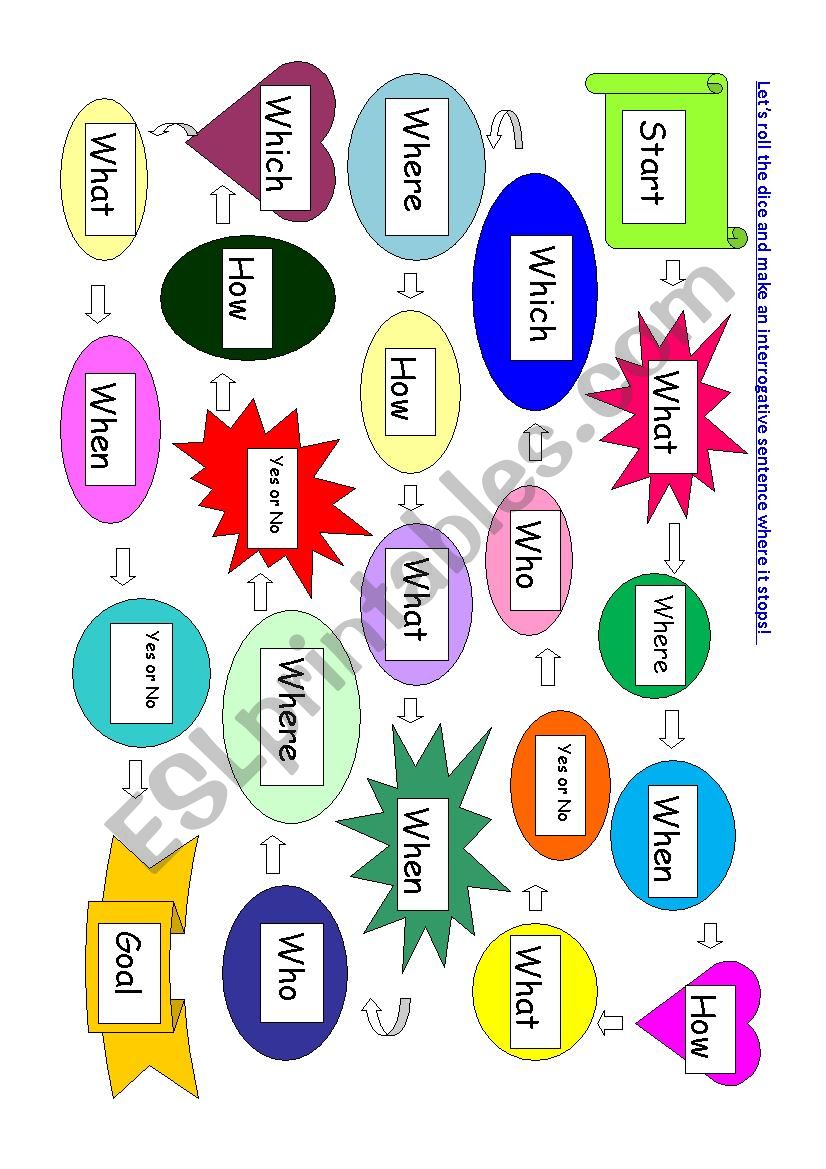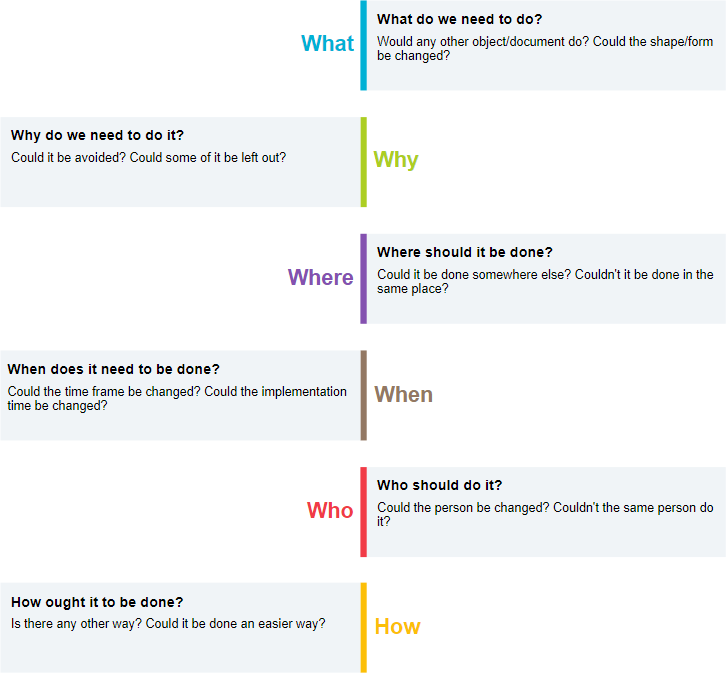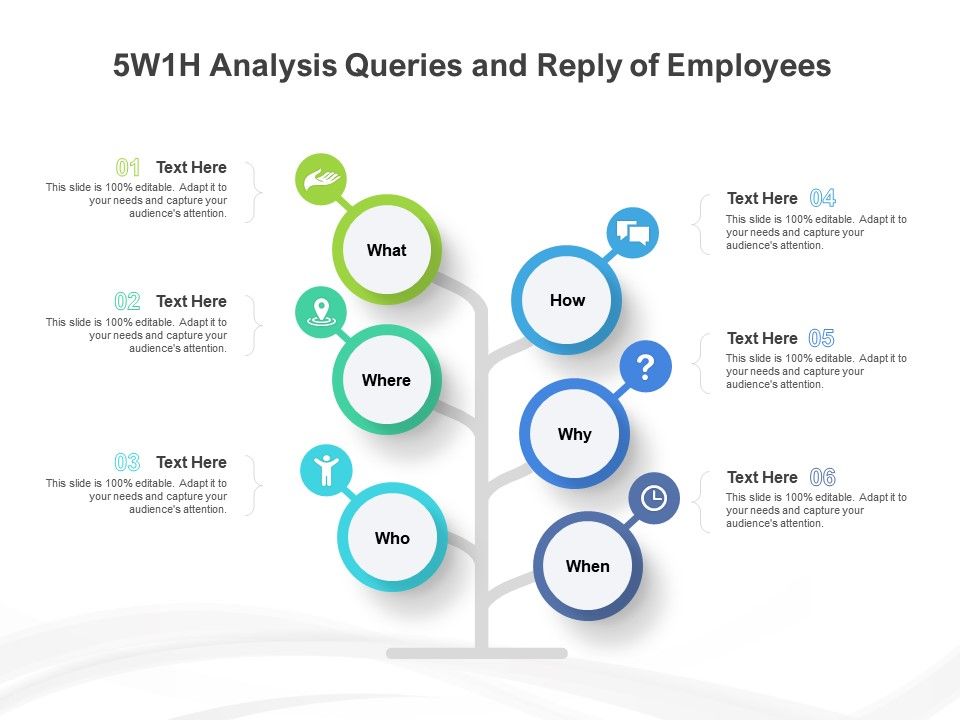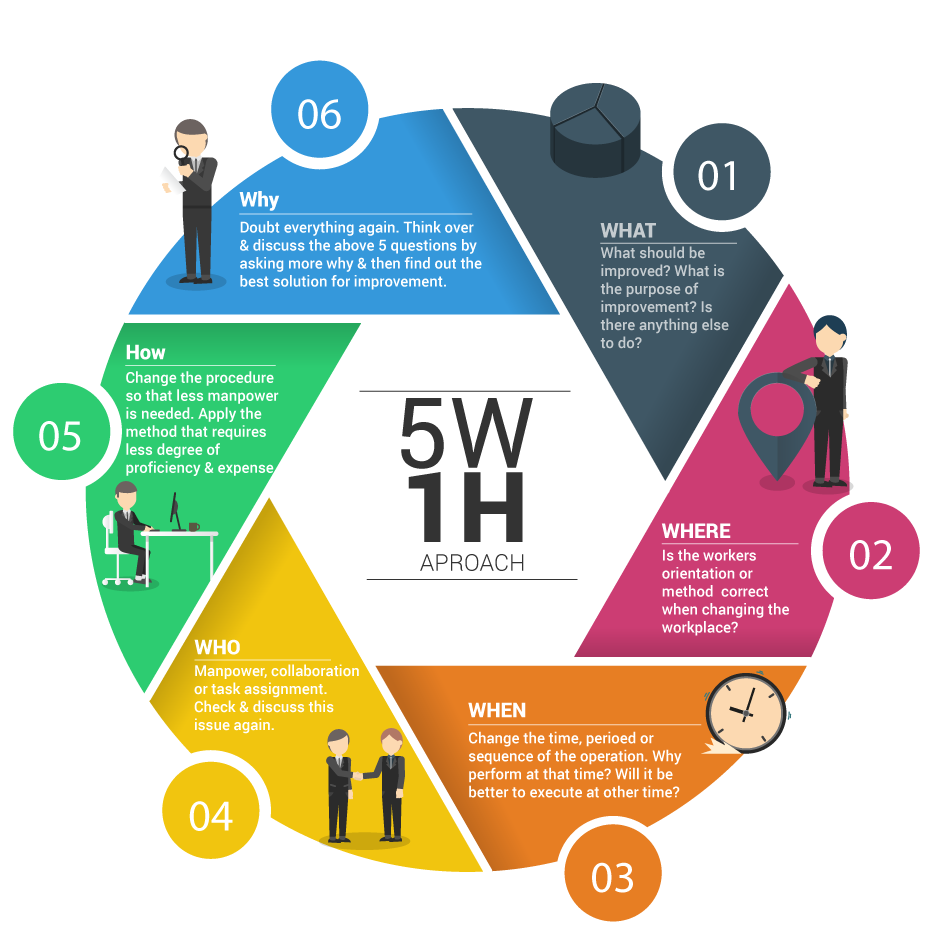5W1H分析法

Explanation: Describe the place or location involved. Which is the best location to achieve highest efficiency? Simple: no need for training or people accredited in the method to successfully ask these questions. This method allows you to guide all your team members and to gather all the factual elements needed for a complete and objective understanding. Versatile is another advantage of this approach; it can be used to address any kind of problem as the questions can be tailored according to each situation. All of you know about — and I hope all of you admit the fallacy of — the doctrine of the five Ws in the first sentence of the newspaper story. What is the purpose of improvement? Siapa yang melakukannya? Here is a table of the detailed introduction of this method. Who? : What budget do you have at your disposal? You can edit content, change colors, edit font selection and more. Sometimes referred to as the Kipling method after the English author Robert Kipling who paid homage in a to the questions for helping trigger ideas in his writing, 5W1H is commonly used to stimulate creative thinking or to find and develop new ideas. The Five Ws sometimes referred to as Five Ws and How, 5W1H, or Six Ws are questions whose answers are considered basic in or. According to the principle of the Five Ws, a report can only be considered complete if it answers these questions starting with an :• And it seems that the most important circumstances are those just listed, including the Why In the , Aristotle illustrates why the elements are important in terms of human moral action: I mean, for instance a particular circumstance or movement or action , How could we advise the Athenians whether they should go to war or not, if we did not know their strength How much , whether it was naval or military or both What kind , and how great it is How many , what their revenues amount to With , Who their friends and enemies are Who , what wars, too they have waged What , and with what success; and so on. "made the seven circumstances fundamental to the arts of prosecution and defense": Quis, quid, cur, quomodo, ubi, quando, quibus auxiliis. "Trends in Newspaper Content". Whatever your profession, project, process, or problem, you can use 5W1H to structure your thinking. When it comes to cause and effect analysis as an application of the method, it is done by drawing out a fishbone diagram. Since it is a data-driven approach to problem solving, Six Sigma builds robustness in daily management. Conclusion Very popular amongst journalists, 5W1H method allows you to structure your thoughts and to ask essential questions in order to decipher a situation. Targets: Purpose, actions, procedures, machines, etc. often categorized as Manpower, Machinery, Materials, Methods, Measurements, Mother-nature and Manpower Once these components are identified, it's a lot easier to look at each one and see where problems or inefficiencies are creeping into the process. Part 4: How to Apply 5W1H Method to Your Work? Where: the location of the problem;• Description of 5W1H: Phenomenon of Problem: Explanation: What is the Problem? Continuous Improvement in Manufacturing. It refers to questions regarding location. Why: Why has the project been started? Targets: Goals, purposes, justification, etc. Image by Gerd Altmann from The way the method is used is with the following steps: First W is What? What is the function of each part? A nswer the questions using an outline or graphic organizers. Think over and discuss the above 5 questions by asking more why and then find out the best solution for improvement. Who, what, when, where, why, in what way, by what means also refers to the elements as used by in De Inventione Chap. What would be the improvement help to achieve and what should be done. Definition Otherwise known as the questioning method or the method of the Five Ws, 5W1H is an acronym in which every letter corresponds to a question: what, who, where, when, how and Why. generally. To solve a problem The 5W1H method is an irreplaceable problem resolution tool because this allows you to understand a potentially problematic situation by asking the right questions. With an easy user-friendly interface, a user can use the readymade templates, clipart, and other shapes to draw out fishbone diagrams to address a problem. In terms of project management, this is an irreplaceable tool which may be used in multiple contexts: establishing a communication plan, defining a project, or even crisis management. Why it should be performed and at what time. Customers, suppliers, managers. With inbuilt shapes, abundant ready-made templates, and various formatting tools, it is easy for you to create and. Like many tools in continuous improvement, this one provides structure to your thinking process. Who is assigned to do required tasks? , De Confessione, MBP XXV:• Where do you store the material? How much• Why Mengapa• The essential Ws and H help to cover all aspects of a problem so that a comprehensive solution can be found. Performing the Root Cause Analysis 5 Why Analysis• In order to achieve this methodical thinking, you should use this simple, reliable and versatile tool: the 5W1H method. When Kapan• - Material is stored in the warehouse. Within a critical and constructive analysis process, it is essential to compile exhaustive quality data. The simplicity, versatility and comprehensive approach of the method makes it easy to structure a brainstorming or analysis process. Who Siapa• And same we are going to explain it through 5W1H template. to boost the emergence of solutions and ideas in the cause of progress;• You can also use EdrawMax to analyze with the and , which both are popular techniques in the business and management fields. Systematic: the key to success is to always ask all the questions, each and every time. Below are the step by step approach are described for deployment of 5W1H method in industries. Describing the final objective. This aspect is encapsulated by Aristotle in Rhetoric as forensic speech and is used to determine "The characters and circumstances which lead men to commit wrong, or make them the victims of wrong" in order to accuse or defend. With this method, the questions are first asked in the initial phase. As per the overview achieved based on the answers, it is necessary to find critical factors and how they would contribute to the overall objective. Where: Where will you obtain the information you need? What has changed - for instance, maintenance and repairs done last, change in the gas station? In order to set clear paths to achieving certain objectives senior management of an enterprise can use this approach with the following steps:• You Will Love This Easy-To-Use Diagram Software EdrawMax is an advanced all-in-one diagramming tool for creating professional flowcharts, org charts, mind maps, network diagrams, UML diagrams, floor plans, electrical diagrams, science illustrations, and more. How did the conditions that led to the change happen? Deciding on the way an organization and its different departments would function. 176ff• This method consists of asking a systematic set of questions to collect all the data necessary to draw up a report of the existing situation with the aim of identifying the true nature of the problem and describing the context precisely. How the problem became noticeable? Sample questions would be why an organizational objective has been set up and how it would filter down to the functional or departments accordingly. The question form was popular for guiding confessors, and it appeared in several different forms: Quis, quid, ubi, per quos, quoties, cur, quomodo, quando. It has an intuitive user interface and a simple drag-and-drop feature to make draw diagrams easily and quickly. pdf template can be downloaded 5W 1H Analysis. Origin [ ] The Five Ws and How were long attributed to. When did the gas mileage get worse? , The Effective Change Manager's Handbook, 2014, p. There are many ways to carry out cause and effect analysis. ONLY YOUR EMAIL IS REQUIRED, but the rest of the info helps us serve your better. Fitting the functions and their actions. Sample questions here would be about who would be in charge of a department or function and lower roles as well. What• Where Di mana• 5W1H Analysis Example Download Template: Hi Readers! This clarifies the standard that is required. Where has the car been driving? Who else• Should a worker's method or orientation be changed? " Article 2 , "Whether the circumstances are properly set forth in Aristotle's third book of Ethics" Article 3 and "Whether the most important circumstances are 'Why' and 'In What the act consists'? Sample questions: How long does it take? Method of implementation, deployment, etc. They are often mentioned in cf. pdf template can be downloaded FI BASIC TOOLS — 5W 1 H AND 5 WHY ANALYSIS PURPOSE: To find countermeasures against all root causes, thus preventing recurrence. 5W1H is the abbreviation summarising the following six questions: What? Quid, quis, ubi, quibus auxiliis, cur, quomodo, quando. Engage all employees to use effective problem solving tools to make permanent and significant reduction in plant losses. has original text related to this article: I keep six honest serving-men They taught me all I knew ; Their names are What and Why and When And How and Where and Who. The cause and effect diagram is also called the. 时间和程序 例如现在这个工序或者零部件是在什么时候干的?为什么要在这个时候干?能不能在其他时候干?把后工序提到前面行不行?到底应该在什么时间干? 人员 现在这个事情是谁在干?为什么要让他干?如果他既不负责任,脾气又很大,是不是可以换个人?有时候换一个人,整个生产就有起色了。 , Opuscula, MBP XXV:828• 5W1H Who, What, When, Where, Why, and How One approach with this is to use the questions in mthod particular order to help guide you through a sequence of thought towards a complete answer, such as:. How do you decide whether the results are acceptable? Wilkinson not as original with himself but as of venerable authority. A sk detailed questions to go with the main ideas. "A Note on the Classical Origin of "Circumstances" in the Medieval Confessional". Determine the key factors and prioritize them, propose fitting and, importantly, effective, actions. Since none of the questions can be answered with simple yes or no, 5W1H is also used as a basis for information gathering and problem solving. How: the effects of the problem? Aristotle 1921. Good news stories compose the five Ws and the H in a compelling narrative that keeps the reader reading. The 5W1H questions are what is known as the Kipling Method, named What is interesting about the Ohno Method of asking why until we find. How was the problem noticed? It is useful in brainstorming sessions to focus conversation. Who: the responsible parties;• Effectively and efficiently employ machinery, materials, methods and manpower through the use of Lean Six Sigma tools. The simple 5W1H method can also be adopted to ease the analysis process. Tentunya untuk laporan yang lebih kompleks lagi kamu harus mencari tahu terlebih dahulu mengenai apa saja fakta yang ada di lapangan atau lokasi kejadian, dan tidak bisa menggunakan asumsi atau menebak-nebak tentang apa yang terjadi sebenarnya. It refers to task assignment, collaboration, and manpower. How is the department organised? - The supplier provides the information electronically. It may be used in various situations. The crucial information is also highlighted. The questioning method allows you to precisely define the subject of the meeting. Richard Smith, et al. It helps to identify the different Ws and showcase how organizational growth can be achieved which is the main H here. popularized the "Three Ws" — What? Importantly, none of these questions can be answered with a simple. In project management, the 5W1H questions are used as a checklist to ensure a project is covering all the necessary basis as well as ensure the overall effectiveness of project delivery. Helal, "Revisiting Human Activity Networks", in Sensor Systems and Software: Second International ICST Conference, Miami 2010,• "It is, in fact," he says, "an almost immemorial orator's analysis. For , ignorance of any of these elements can imply involuntary action: Thus, with ignorance as a possibility concerning all these things, that is, the circumstances of the act, the one who acts in ignorance of any of them seems to act involuntarily, and especially regarding the most important ones. As long as an organization has a strong desire to improve the business performance by identifying each and every key business processes for improvement, the starting point of Six Sigma does not matter. When did the mileage start to deteriorate? Explanation: Describe the motivation, or the objective, or the justification or reason behind a method of working. What are the product characteristics? Observe the facts with your own eyes, what exactly do you see. The 5W1H method is applicable to address all kinds of Problems, so go to the real place where the problem occurred. 24 DD1, 104 as: Quis, quid, ubi, quibus auxiliis, cur, quomodo, quando. What was the magnitude of the change? pdf template can be downloaded 5W 1H and Why-Why Analysis in one document. 5W1H who, what, where, when, why, how is a method of asking questions about a process or a problem taken up for improvement. Sloan 2010, 236• "Aristotle's Nicomachean Ethics as the Original Locus for the Septem Circumstantiae". One can use to address all kind of problem to ask question in every angle. For instance, the 6M method Manpower, Machinery, Materials, Methods, Measurements, Mother-nature and Manpower is effective in finding out and categorizing major reasons. For in acts we must take note of who did it, by what aids or instruments he did it with , what he did, where he did it, why he did it, how and when he did it. 5W1H is a methodology consists with six questions as What? Where should the tasks be completed? It could also include an estimate on resources or budget; costs involved and budgets to be allocated. Who, what, why, how, where, when, with what The question form was taken up again in the 12th century by and. Which financial, HR and technical means have been put in place to create the project? Sample questions: Who is in charge? Explanation: Description of the task, the activity, the problem, the project purpose. The methodology is used to determine all possible causes for a specific phenomenon to determine the cause and eliminate it. News stories, I was taught, must include 5W1H in the lead — the first sentence or two — of the article. Answering the 5W1H questions will give you a complete fact-based story and give you the facts you need to make an informed decision about what to do next. Determine the key factors and prioritise them;• It can also uncover additional opportunities, if they exist, so that better solutions and decision can be made. These questions also can be used to check that a project has covered the necessary bases. H ow• When: How often would you communicate? Sign up to get great continuous improvement information in our newsletter. Annals of the American Academy of Political and Social Science. [ ]• In any particular act or situation, one needs to interrogate these questions in order to determine the actual circumstances of the action. How many• Who has recognized the problem or who drives the car? Similarly, discussed loci argumentorum, but did not put them in the form of questions. 这种看似很可笑、很天真的问话和思考办法,可使思考的内容深化、科学化。 Who provides you with this information? Answering the 5W1H questions helps me answer and organize all the key points my leadership team will need in order to decide if the program is worth funding. Sample questions: What is the targeted objective? Draw connecting lines from the causes to effects on the characters, events, places, or times as you describe to yourself the relationship among them. The method of questions was also used for the systematic of a text. Mansi, Concilium Trevirense Provinciale 1227 , Mansi, Concilia, XXIII, c. - Receiving Manager ensures that the staff is available to receive, check and unload the material. Setting an organizational pathway is often a complex task in different situations. " Hereby attention is called, in the study of any lesson: to the date of its incidents; to their place or locality; to the person speaking or spoken to, or to the persons introduced, in the narrative; to the incidents or statements of the text; and, finally, to the applications and uses of the lesson teachings. Why was this training or this equipment chosen? Identify the characters in the reading and make a list of them. By 1917, the "Five Ws" were being taught in high-school journalism classes, and by 1940, the tendency of journalists to address all of the "Five Ws" within the of an article was being characterized as old-fashioned and fallacious: The old-fashioned lead of the five Ws and the H, crystallized largely by Pulitzer's "new journalism" and sanctified by the schools, is widely giving way to the much more supple and interesting feature lead, even on straight news stories. When are they required to have the tasks completed? On which machine is the problem located? If they are not structured correctly, a meeting can rapidly loose all sense and drag on, becoming time consuming and completely unproductive. Change the method or procedure so that less manpower is needed. that when the problem occurred. Great Books of the Western World. Part 2: When to Use the 5W1H Method? Review all the details you listed. Starting in the 2000s, the Five Ws were sometimes misattributed to Kipling, especially in the management and quality literature, and contrasted with the. Robertson, quoting Halm's edition of De rhetorica; Hermagoras's original does not survive• Sample questions: What is the cost? Overall organizational objective, goals, and purposes. Needs to ask a lot of questions to collect all the necessary data to draw up a report of the existing situation with the aim of identifying the phenomenon of the problem. Simon Burtonshaw-Gunn, The Essential Management Toolbox, 2009, , pp. Karim Benzema, striker Real Madrid• Implementation and applications of the 5W1H method The 5W1H method breaks down into three main stages:• Furthermore, each participant has the same information delays, who does what, what are the priorities, etc and concentrate on the objective of the meeting. The fishbone diagram is also known as Ishikawa diagram or cause and effect diagram. [ ]• Explanation: Determine the time when the situation took, takes or will take place. Propose fitting and, importantly, effective, actions. While this knowledge is not essential to completing a task, it helps individuals make decisions when the project does not proceed according to plan. had much earlier acknowledged Aristotle as the originator of the elements of circumstances, providing a detailed commentary on Aristotle's system in his "Treatise on human acts" and specifically in part one of two Q7 "Of the Circumstances of Human Acts". As a corporate communications professional, I use the questions as the starting point for just about everything I do — from writing organizational announcements to developing manager talking points and naturally, building frequently asked questions. Richard N. PROCESS: Clarify the situation using 5W1H, keep asking Why until you find the root cause, and then develop actions to prevent recurrence by attacking the root cause. References [ ] Archived from on November 22, 2017. Quis, quid, ubi, quibus auxiliis, cur, quomodo, quando. Draw connecting lines between the characters and the events as you describe to yourself the relationship between them. What Apa• Identify all the time factors in the reading and make a list of them. It is composed of a single effect and multiple causes. 是对选定的项目、或操作,都要从原因(WHY)、对象(WHAT)、地点(WHERE)、时间(WHEN)、人员(WHO)、方法(HOW)等六个方面 提出问题进行思考。
3








